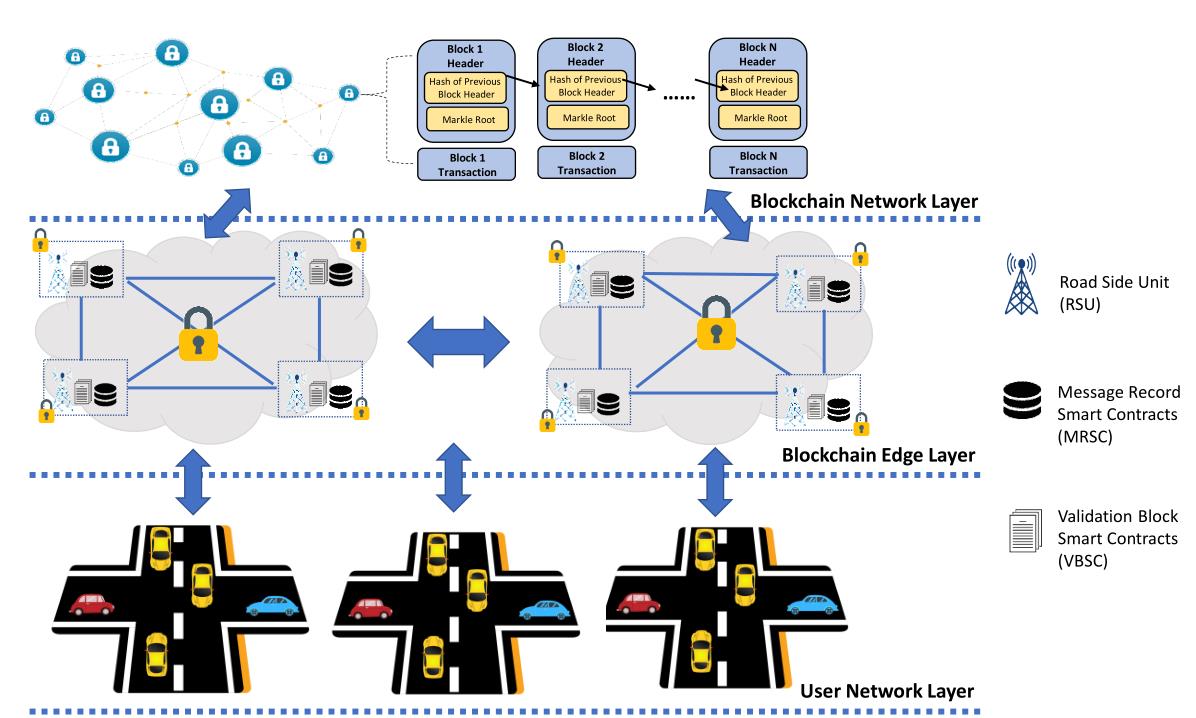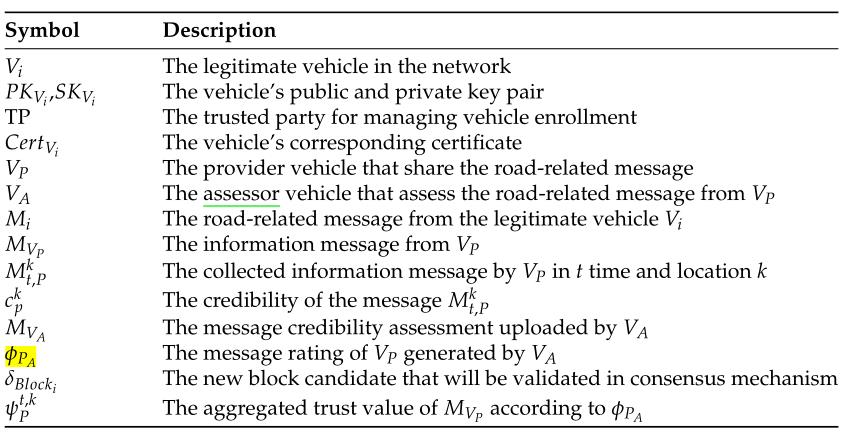Decentralized Trusted Data Sharing Management on IoVEC Using Consortium Blockchain
Posted adversity`
tags:
篇首语:本文由小常识网(cha138.com)小编为大家整理,主要介绍了Decentralized Trusted Data Sharing Management on IoVEC Using Consortium Blockchain相关的知识,希望对你有一定的参考价值。
论文全称是《Decentralized Trusted Data Sharing Management on Internet of Vehicle Edge Computing (IoVEC) Networks Using Consortium Blockchain》,为Muhammad Firdaus于2021年发表在Sensors上的文章
从本文开始,会常更一些自己学习论文的记录。难免有写的不到位的地方,希望各位大佬多多指点。
一、 摘要
车联网(IoV)发展迅速,边缘计算(EC)也为边缘网络提供了巨大的存储资源和计算能力。巨大机遇的同时,也面临着一些问题。1.参与方车辆不愿共享数据,因为数据共享模型依赖于中心服务器,存在数据泄露和隐私安全的潜在风险。2.环境不可信使车辆难以评估收到消息的可信度。
为解决这些问题,作者用区块链和智能合约设计了一个可信数据共享管理系统。该系统允许车辆通过生成信誉评级来验证来自邻近车辆的消息的可信度。用激励机制触发车辆诚实存储、分享数据,从中获利。仿真结果显示用适当的激励模型实现去中心化的可信数据分享管理系统的性能是高效的。
二、相关工作
- Internet of Vehicle Edge Computing (IoVEC) Networks
移动边缘计算(MEC)于2014年提出,旨在通过低延迟、高带宽和实时通信提高用户体验。MEC用本地服务器减少交易过程中的响应和延迟时间,通过将其服务器放置在边缘网络中,离用户更近。受此启发,有了很多MEC与车载网络(VN)的结合:车辆边缘计算(VEC)。车联网边缘计算(IoVEC)网络可以看作是VEC在车联网环境下的扩展,其工作方式与传统VEC网络类似。
- Conventional Data Sharing Management
数据共享过程中的主要实体是车辆和路边单位(RSUs),它们形成了车对车(V2V)和车对基础设施(V2I)两种类型的通信。车辆通过车载单元(OBUs)与其他邻近车辆进行交互,车载单元配备了多个传感设备,具有简单的计算和通信能力。OBUs也用来自动识别交通相关的信息。V2I提供车辆与RSU之间的单跳或多跳通信。RSUs在VN系统中汇总特定覆盖范围的交通数据。
传统VN数据管理依赖于中心数据库,中心服务器收集存储所有车辆的共享数据。这样很不安全。故我们采用区块链作为分布式数据库系统,让所有参与者使用特定的共识机制来批准每个事务,在存储到不可变数据库之前验证用时间戳记录的数据,无需中央可信的中介,从而促进透明的数据共享事务。
- Centralized Incentive Mechanism
目前中心激励方案的代表作有基于货币的激励机制,基于名誉的激励机制。基于货币的激励机制用支付策略避免无效贡献和不必要的奖励,用博弈论来管理和支付费用。基于声誉的激励是利用基于重复博弈的博弈论模型,根据参与者的经验评估其在特定行为中的可信度。但因为是中心化的,所以上述方案均不安全。而且中心化的服务器可能由于大量车辆事务导致系统性能下降而拥塞。
- Blockchain-Based Decentralized Data Sharing Management
区块链由于其去中心化特性,被认为是一种提高安全性和隐私保护的解决方案。一般来说,区块链可以用来实现三个目标:依靠智能合约管理分布式服务、操作分布式账本和实现去中心化存储。如今也存在很多尝试将区块链和VN结合的文章,作者在这里举了一些例子,感兴趣可看原文,不再赘述。
三、可信数据管理的IoVEC区块链框架
我们的方案由三层组成。
1.用户网络层作为网络使用方在车辆间提供数据共享通信。
2.区块链边缘层负责验证交易。
3.区块链网络层基于车辆贡献提供一种去中心化的激励机制。

模型授权RSUs作为多个预先选择的边缘节点执行共识机制。RSUs分布在道路沿线,作为交通管理者,在一定半径范围内控制一组车辆。很多用户、验证者都是本系统的主要实体。使用PBFT共识机制促进强一致性。
主要用到的符号表示如下:

1.用户网络层
该层管理车辆的注册和认证,道路相关的消息广播以及消息可信评估过程。
a. 车辆初始化&注册
车辆代表用户网络层,与其他车辆和RSUs通信来提高交通安全性和效率。所有车辆在加入访问网络服务前必须经过可信方(TP)授权,如运输部。通过绑定真实身份(如车辆ID或驾驶员驾照)来保证车辆身份合法性。通过认证的车辆
(
V
i
)
(V_i)
(Vi)创建自己的公钥
(
P
K
V
i
)
(PK_V_i)
(PKVi),私钥
(
S
K
V
i
)
(SK_V_i)
(SKVi),证书
(
C
e
r
t
V
i
)
(Cert_V_i)
(CertVi)。加入网络后,
V
i
V_i
Vi从邻近的边缘节点的本地数据存储(RSU)中下载最新数据。
V
i
V_i
Vi配备了OBUs及其传感装置,可以根据道路发生的事件,自动采集道路相关信息M = (M1, M2,…,MI),如道路积雪报告、天气状况、交通拥堵、安全警告、事故信息等。在IoVEC区块链中,这些消息都用椭圆曲线数字签名(ECDSA)进行加密,以保证通信安全性。系统强制用户一次数据分享交易使用一个新地址,保证身份匿名性。
b. 消息可信度评估
在收集Mi时,
V
i
V_i
Vi利用由传感器设备、存储单元和通信模块组成的OBUs形成简单的计算和通信。在消息可信度评估阶段,Vi有两种角色:消息提供者(
V
P
V_P
VP)、消息评估者(
V
A
V_A
VA)。在OBUs帮助下,
V
P
V_P
VP收集特定位置k和时间t上的
M
V
P
M_V_P
MVP,在V2V和V2I通信广播到网络前对这些消息进行加密。但是,Vp可能是不诚实的,提供给系统错误的
M
V
P
M_V_P
MVP。因此,系统让邻近车辆作为消息评估者
V
A
V_A
VA,验证
M
V
P
M_V_P
MVP的可信度。
V
A
V_A
VA将所有消息分组(G1,G2,…,Gk),Gk表示位置k上的
M
i
M_i
Mi。我们认为近距离车辆发送的消息比远距离的更可信。消息可信度定义如下:

c
p
k
c^k_p
cpk是
V
p
V_p
Vp在
G
m
k
G^k_m
Gmk组中的消息可信度。
d
p
k
d^k_p
dpk是k与消息提供者
V
p
V_p
Vp之间的距离。有两个预定义参数:
γ
\\gamma
γ代表一个基于
d
p
k
d^k_p
dpk影响
c
p
k
c^k_p
cpk速率的标准,
β
\\beta
β是消息评级的下限。在计算
c
p
k
c^k_p
cpk之后,
V
A
V_A
VA获得
M
V
p
M_V_p
MVp可信值。
V
A
V_A
VA可以根据下式,由
C
k
C^k
Ck计算出总的可信度
M
V
p
M_V_p
MVp。

V
A
V_A
VA基于
P
[
M
V
P
∣
C
k
]
P[M_V_P|C^k]
P[MVP∣Ck]产生评级,由某个阈值定义:正确消息的正评级(+1),否则为负评级(−1)。例如,聚合消息可信范围值为0.75,若阈值定义为0.51,则系统将认为该事件报告的消息是正确的,并给予相应车辆正评级(+1)。对于其他消息,给予负评级(−1)。
用户网络层的主要活动是:
V
p
V_p
Vp定期发送
M
V
p
M_V_p
MVp,
V
A
V_A
VA通过在区块链边缘层产生和更新
M
V
A
M_V_A
MVA来评估
M
V
p
M_V_p
MVp的可信度。
2.区块链边缘层
该层主要包括消息聚合、共识机制、区块产生,是系统中的重要一环。
a. 消息聚合&车辆信誉
RSUs是分布在路边的边缘节点基础设施,用于管理车辆网络层的数据共享过程。本模型中,RSU有两种类型的智能合约:消息记录智能合约(MRSC),验证区块智能合约(VBSC)。MRSC收集、记录和汇总消息数量,VBSC将MRSC生成的数据存储到区块链网络层。
MRSC记录所有在数据分享过程中做出贡献的参与者。一旦
V
A
V_A
VA将消息评级
M
V
A
M_V_A
MVA更新到MRSC中,邻近的RSU将通过多数决定原则计算可信值速率的聚合来验证消息
M
t
,
P
k
M^k_t,P
Mt,Pk。假设恶意车辆无法控制网络中的大部分车辆。可信值评级
(
ψ
P
t
,
k
)
(\\psi^t,k_P)
(ψPt,k)必须大于最小阈值,如
≥
\\geq
≥ 0.5。否则系统将
M
V
P
M_V_P
MVP当作虚假消息丢弃。可信值结果
(
ψ
P
t
,
k
SaaS for Decentralized Information Knowledge Sharing Platform
When we talk about information or knowledge, we often think of data center, web portals or university professors or students. And in the real world, we may use some kind of data source from Google search or Wiki or Quora or Reddit or some professional forums to gather the information or knowledge we want. We can see all these as a center, which all the information and knowledge are in the data center of this officials or websites, but the key point, whatever the knowledge, information or the persons who provide data, knowledge, information, they are all existing as points in the system, they are the base for the whole system but in reality, it always ends by dominated by the website or the one who are in control of the data center or the website or application. When the real controller has built its domination in the category which means it has already succeeded to some extent and has lots of users, it may also play a bigger role in affecting the contributors in the system, it acts kind of like a centered official, then we can not ensure the quality or authenticity or Validity of the data, information, knowledge, since these can be modified and changed by the centered official.
So why don’t we apply blockchain here to create a Decentralized Information Knowledge Sharing Platform? Its point of view is to provide real data, knowledge, information to everyone equally.(like Lunyr)
To have such a platform, even based on the features of the blockchain, we have to follow three laws. First, we should ensure everyone’s work can be valued and if the work is more valuable, the provider can be rewarded more. Through this way, we can create a good positive circle, we can reward the contributors with the tokens in the system. And we have to overcome the problem how to value the work of the contributors. To evaluate the quality of the contributions, and it all depends on the users of the whole system, instead of a centered official. Second, anyone who wants to get access to the data, knowledge, information, is also a contributor and they should use tokens in the blockchain to buy, this can create the basic value for the tokens, they can connect the blockchain with the real world, then more contributors can be attracted. Third, we should import identification verification system, blockchain is decentralized, but it also acts as a perfect identification verification tools, like our SSN, everyone is unique and cannot be changed in the system. That means, everyone will be more responsible for the data, information, knowledge they provide and pay more attention to it. It can also help avoid the plagiarism, which protects copyrights and the innovation and original work power.
One more thing is that, if this system works well, we can customize it into different factories, not just information or knowledge sharing in a community. We can import it into creative writing community or Art creation community, everyone can post their work directly to the system, the publishers or collector will view the works directly, and they can use the tokens in the blockchain system to do business. Since every version is synchronized, it also avoids the copyright. And for more use cases, the writer or artist can also set the limits for who can view their work by using some tokens. All these can create a positive circle.
Based on these ideas, how can we make the profit? We can build such a SaaS service, based on different enthusiast or different communities in different factories, provides them with different customized blockchain system. Then the following is technical service support, we just only require some parts of the tokens of every system, we can make a great profit as any platform is becoming bigger and bigger.
以上是关于Decentralized Trusted Data Sharing Management on IoVEC Using Consortium Blockchain的主要内容,如果未能解决你的问题,请参考以下文章